Simulation of Achievable Data Rates of Broadband Power Line Communication for Smart Metering
Abstract
:1. Introduction
- Ultra-Narrow Band (UNB) operates at a very low data rate (100 bps) in the low frequency band (0.3–3 kHz). UNB uses one-way communication, used for load control in particular. UNB has a very large operational range (hundreds of kilometres).
- Narrowband (NB) operates in the frequency band 3–500 kHz (3–148.5 kHz in Europe). Single-carrier NB technologies achieve data rates of a few kbps-Low Data Rate NB-PLC (LDR NB-PLC). Nowadays, multicarrier technologies are capable of data rates of up to 800 kbps-High Data Rate NB-PLC (HDR NB-PLC).
- Broadband (BB) operates in the high frequency band (1.8–30 (250) MHz) and has data rates of several Mbps up to hundreds of Mbps.
- Narrowband with a single-carrier (e.g., Open Smart Grid Protocol (OSGP), Meter and More, or G1-PLC). This communication will reach large distances (good coverage). Data rates are adequate for current smart metering needs, though may not be so for next-generation Smart Grid services. Protocols are maximally optimized and proprietary. However, there is a concern that higher throughput would be required to fulfil the evolution of Smart Grid applications (e.g., prediction, real-time control, or control time varying the nature of wind and photovoltaic sources). In view of the lack of standardization, Echelon are trying to implement their OSGP protocol as a standard [10].
- Narrowband with OFDM (e.g., PRIME, G3-PLC, IEEE P1901.2, and ITU G.hnem standards). In comparison with narrowband with a single carrier it has a smaller range (low coverage), but thanks to DLMS/COSEM it has excellent standardization. Smart meters from different manufacturers can be used side by side in one network.
- Broadband (e.g., TIA-1113, HomePlug, IEEE 1901, ITU-T G.hn). This communication reaches high data rates but has lower communication distances (coverage) than narrowband and OFDM. BB-PLC provides a solution for high bandwidth requirements to support the evolution of Smart Grid applications, but estimation on why much higher data rates may be needed is still missing. Again, despite the use of the TCP/IP standard, protocols are proprietary for energy solutions, and it is not possible to deploy equipment from different manufacturers side by side in one network. New standards IEEE 1901 and ITU-T G.hn provide a new solution for coexistence and high performance. The drawback of BB-PLC is the allowable frequency bandwidth, for example, if BB-PLC is used in medium voltage (MV) lines, its performance significantly decreases due to the need to control available frequency bandwidth (power spectral density).
2. Communication Network Architecture for Smart Metering
- Neighbourhood area network (NAN) or field area network (FAN). These networks provide communication from end devices (e.g., Smart Meters) to data concentrators located at medium voltage/low voltage (MV/LV) transformer substations.
- Wide area network (WAN). This network provides communication from the utility head end out to data concentrators located at MV/LV transformer substations.
Smart Metering Application and Communication Requirements
- Reliability >98%.
- Latency: seconds.
- Typical data size: 100–2400 bytes/per meter with sampling 1 min or 15 min.
- Data rate 100 kbps–10 Mbps.
- Transmission from a large number of smart meters.
- Low cost.
- Simplicity.
- Secure communication and data privacy.
3. Performance of Broadband Power Line Communication—Related Works
3.1. BB-PLC Standardization
3.2. Achievable Data Rates of Broadband Power Line Communication—Related Works
- Narrowband noise. This type of noise is time-variant, and it is the result of interference from other services operating in the same frequency range with BPL. This type of noise is hard to describe and model. The impact of narrowband noise in MV lines on performance is not significant. Our previous measurements [28] show that the narrowband noise caused a decrease of units of dB in the average SNR. This decrease caused only a small decrease in the total throughput.
- Coloured background noise. This type of noise is caused by corona phenomenon [32] and depends on geographical location, type of cable (overhead, underground), height of cables above the ground, etc.
3.3. Repeaters Positioning in PLC Networks—Related Works
4. Evaluation of PLC Systems for Smart Metering Using Simulation Tools—State of the Art and Motivation
Simulation Goals
- Is it possible to design replicable and repeatable methodology for the evaluation of PLC technologies for Smart Metering deployment?
- Is it possible to perform experimental evaluation of PLC using a simulation tool and find the limits of particular PLC technologies, which will correspondent with real deployment?
- The impact of topological parameters and physical characteristics of the power line on throughput (channel link capacity).
- The impact of noise on throughput (channel link capacity).
- The impact of repeaters on throughput and reliability of communication.
- Communication distances without repeaters.
5. NS-3 Simulation Tool
5.1. Channel Transfer Function
5.2. Channel Link Capacity
6. Simulation—Basic Topologies
- The influence of background noise on channel capacity.
- The influence of direct line length from transmitter to receiver on throughput.
- The influence of number of branches on throughput.
- The influence of branch (tap) length on throughput.
- The effect of branch length, number of branches, terminal load impedances, and time frequency varying behaviour on channel capacity.
6.1. Simulation Set-Up
- The frequency band 1.8–30 MHz for broadband PLC.
- The 64PSK modulation.
- According to IEEE 1901 standard and FFT OFDM PHY specifications, 917 active carriers were considered.
- Transmitter impedance was 40 Ω, receiver impedance 100 Ω, and node impedance was 250 Ω.
- Transmitting power was −50 dBm/Hz.
- Background noise for basic topologies was set according to real measurements [54] on the value of −90 dBm/Hz. This value represents ideal condition or environment in the real power line networks.
6.2. Influence of Background Noise on Channel Capacity
- −90 dBm/Hz for ideal conditions (laboratory condition and on-field good condition).
- −70 dBm/Hz for on-field very noisy condition (worst-case noise scenario).
6.3. Influence of Direct Line Length from Transmitter to Receiver on Throughput
6.4. Influence of Number of Branches on Throughput
6.5. Influence of Branch (Tap) Length on Throughput
6.6. Influence of Terminal Load Branch Impedance on Throughput
6.7. Influence of Position of the Branch (Tap) on Throughput
6.8. Summary—Influence of Individual Parameters on Throughput
- Background noise: The most significant source of throughout degradation caused by the different types of noise in LV networks.
- Direct line length: The capacity of the cable channel decreases almost logarithmically with increasing length of the cable between transmitter and receiver. The capacity decreases approximately by 4 Mbps from 22 Mbps to 18 Mbps for 150 m of cable between transmitter and receiver. This capacity drop is less significant for longer distance between transmitter and receiver. For example, some simulation results [61] show capacity decrease with increasing length of the cable between transmitter and receiver.
- Number of branches: The capacity decreases approximately by 2 Mbps with an increase in the number of branches (two and three).
- Branch (tap) length: The increasing length of a branch caused decreasing channel capacity, but for a large distance between transmitter and receiver it is not significant. The drop of 0.23 Mbps from 3.15 to 2.92 Mbps is caused by increasing length of a branch from 15 m to 45 m.
- Terminal load branch impedance: The changes of terminal load impedance lead to deep notches in CTF, therefore the throughput changes slightly.
7. Simulation—Real Topology
7.1. Topology Description
7.2. Simulation Set-Up
- The frequency band 1.8–30 MHz for broadband PLC.
- QAM64 modulation.
- According to IEEE 1901 standard and FFT OFDM PHY specifications, 917 active carriers were considered.
- Transmitting power was 13.8 nW according to a previous study [53].
- Background noise was set up according to real measurements [54] at the value of −70 dBm/Hz. This value represents very noisy conditions in the real power line networks.
- The throughput on physical layer of 1 Mbps at the minimum was considered for simulation.
7.3. Methodology for Finding Repeaters Position
- Head End node, also called the Master. The position of the Head End node is always in the transfer station (node n1).
- Repeater node, which behaves as a slave for the Master and a Master (Time Division Repeater (TDR)) for the slaves.
- Customer Premise Equipment (CPE), also called the slave node.
- The HE master sends continuous invitation. When a CPE detects an access network, it will start the Access Protocol in order to obtain access to the network (to find master). The master will select the best CPE according to certain criteria (throughput and SNR).
- Once a CPE is connected to a master, it can re-evaluate its status to the TDR, and can establish a new connection to a new CPE (which is not visible thanks to the distance to the HE master), according to certain criteria (throughput and SNR). TDR units have the main function of extending the coverage over a longer distance.
- TDR sends continuous invitation and CPE starts the Access Protocol in order to obtain access to the network (to find master or TDR).
- Repeated for the whole topology to build network hierarchy.
- The second step takes place after the auto-configuration process and every period (e.g., three hours).
- The throughput and SNR are evaluated between the HE node (n1) and the following nodes in the topology (nx) until the throughput does not drop below 1 Mbps or SNR below 3.
- The nx node is set-up as a new repeater (TDR).
- The throughput and SNR are evaluated between the TDR node (nx) and the following nodes in the topology (nxx) until the throughput does not drop below 1 Mbps or SNR below 3.
- Repeated for whole topology after the CPE is found.
- Optimization of positions of repeaters according to knowledge of throughput and SNR of all possible communication paths.
7.4. Results—Real Topology
7.5. The Influence of Cable Type on Transfer Function and Throughput
8. Measurement in Real Topology—Evaluation of Simulation
- Verification of the simulation results of BPL, especially these parameters:
- ○
- Reliability of communication;
- ○
- Number of repeaters;
- ○
- Communication distances without repeaters.
- Comparison of simulation and measurement result of BPL with NB-PLC with single carrier.
Comparison with Simulation Results
9. Conclusions
Author Contributions
Acknowledgments
Conflicts of Interest
References
- Andreadou, N.; Guardiola, M.O.; Fulli, G. Telecommunication Technologies for Smart Grid Projects with Focus on Smart Metering Applications. Energies 2016, 9, 375. [Google Scholar] [CrossRef]
- Mlynek, P.; Misurec, J.; Fujdiak, R.; Kolka, Z.; Pospichal, L. Heterogeneous Networks for Smart Metering—Power Line and Radio Communication. Elektron. Elektrotech. 2015, 21, 85–91. [Google Scholar] [CrossRef]
- Galli, S.; Scaglione, A.; Wang, Z. For the Grid and Through the Grid: The Role of Power Line Communications in the Smart Grid. Proc. IEEE 2011, 99, 998–1027. [Google Scholar] [CrossRef]
- Fang, X.; Misra, S.; Xue, G.; Yang, D. Smart Grid—The New and Improved Power Grid: A Survey. IEEE Commun. Surv. Tutor. 2012, 14, 944–980. [Google Scholar] [CrossRef]
- Sendin, A.; Pena, I.; Angueira, P. Strategies for Power Line Communications Smart Metering Network Deployment. Energies 2014, 7, 2377–2420. [Google Scholar] [CrossRef]
- Sendin, A.; Berganza, I.; Arzuaga, A.; Osorio, X.; Urrutia, I.; Angueira, P. Enhanced operation of electricity distribution grids through smart metering plc network monitoring, analysis and grid conditioning. Energies 2013, 6, 539–556. [Google Scholar] [CrossRef]
- Chren, S.; Rossi, B.; Pitner, T. Smart grids deployments within EU projects: The role of smart meters. In Proceedings of the Smart Cities Symposium Prague (SCSP), Prague, Czech Republic, 26–27 May 2016; pp. 1–5. [Google Scholar] [CrossRef]
- Ikpehai, A.; Adebisi, B.; Rabie, K.M. Broadband PLC for Clustered Advanced Metering Infrastructure (AMI) Architecture. Energies 2016, 9, 569. [Google Scholar] [CrossRef]
- Sarafi, A.M.; Tsiropoulos, G.I.; Cottis, P.G. Hybrid wireless-broadband over power lines: A promising broadband solution in rural areas. IEEE Commun. Mag. 2009, 47, 140–147. [Google Scholar] [CrossRef]
- Open Smart Grid Protocol (OSGP). ETSI GS OSG 001 V1.1.1 (2012-01). Available online: http://www.etsi.org (accessed on 12 February 2019).
- Sharma, K.; Saini, L.M. Power-line communications for smart grid: Progress, challenges, opportunities and status. Renew. Sustain. Energy Rev. 2017, 67, 704–751. [Google Scholar] [CrossRef]
- Artale, G.; Cataliotti, A.; Cosentino, V.; di Cara, D.; Fiorelli, R.; Guaiana, S.; Panzavecchia, N.; Tinè, G. A new PLC-based smart metering architecture for medium/low voltage grids: Feasibility and experimental characterization. Meas. J. Int. Meas. Confed. 2018, 129, 479–488. [Google Scholar] [CrossRef]
- Kabalci, Y. A survey on smart metering and smart grid communication. Renew. Sustain. Energy Rev. 2016, 57, 302–318. [Google Scholar] [CrossRef]
- Sendin, A.; Arzuaga, T.; Urrutia, I.; Berganza, I.; Fernandez, A.; Marron, L.; Llano, A.; Arzuaga, A. Adaptation of Powerline Communications-Based Smart Metering Deployments to the Requirements of Smart Grids. Energies 2015, 8, 13481–13507. [Google Scholar] [CrossRef]
- Kuzlu, M.; Pipattanasomporn, M.; Rahman, S. Communication network requirements for major smart grid applications in HAN, NAN and WAN. Comput. Netw. 2014, 67, 74–88. [Google Scholar] [CrossRef]
- Lee, M.K.; Newman, R.E.; Latchman, H.A.; Katar, S.; Yonge, L. HomePlug 1.0 powerline communication LANs—Protocol description and performance results. Int. J. Commun. Syst. 2003, 16, 447–473. [Google Scholar] [CrossRef]
- Afkhamie, K.; Katar, S.; Yonge, L.; Newman, R. An overview of the upcoming HomePlug AV standard. In Proceedings of the IEEE International Symposium on Power Line Communications and Its Applications (ISPLC), Vancouver, BC, Canada, 6–8 April 2005. [Google Scholar]
- Yonge, L.; Abad, J.; Afkhamie, K.; Guerrieri, L.; Katar, S.; Lioe, H.; Pagani, P.; Riva, R.; Schneider, D.M.; Schwager, A. An overview of the HomePlug AV2 technology. J. Electr. Comput. Eng. 2013, 892628. [Google Scholar] [CrossRef]
- Galli, S.; Logvinov, O. Recent Developments in the Standardization of Power Line Communications within the IEEE. IEEE Commun. Mag. 2008, 46, 64–71. [Google Scholar] [CrossRef]
- Galli, S.; Koga, H.; Kodama, N. Advanced signal processing for PLCs: Wavelet-OFDM. In Proceedings of the 2008 IEEE International Symposium on Power Line Communications and Its Applications, Jeju City, South Korea, 2–4 April 2008; pp. 187–192. [Google Scholar] [CrossRef]
- Oksman, V.; Galli, S. G.hn: The new ITU-T home networking standard. IEEE Commun. Mag. 2009, 47, 138–145. [Google Scholar] [CrossRef]
- International Telecommunications Union (ITU). ITU-T Recommendation G.9972, Coexistence Mechanism for Wireline Home Networking Transceivers. June 2010. Available online: http://www.itu.int/rec/T-REC-G.9972 (accessed on 12 February 2019).
- Galli, S.; Koch, M.; Latchman, H.A.; Lee, S.; Oksman, V. Industrial and international standards on PLC base networking technologies. In Power Line Communications, 1st ed.; Ferreira, H., Lampe, L., Newbury, J., Swart, T., Eds.; Wiley: New York, NY, USA, 2010. [Google Scholar]
- Cano, C.; Pittolo, A.; Malone, D.; Lampe, L.; Tonello, A.M.; Dabak, A.G. State of the Art in Power Line Communications: From the Applications to the Medium. IEEE J. Sel. Areas Commun. 2016, 34, 1935–1952. [Google Scholar] [CrossRef]
- Liu, H.; Song, J.; Zhao, B.; Li, X. Channel study for medium-voltage power network. In Proceedings of the IEEE International Symposium on Power Line Communications and Its Applications, Orlando, FL, USA, 26–29 March 2006; pp. 245–250. [Google Scholar]
- Bruck, G.H.; Jung, P.; Kocks, C.; Sachsenhauser, B.; Waadt, A. Achievable Data Rates of Broadband Power Line Communications in an Underground Medium-Voltage Network. J. Green Eng. 2013, 3, 245–259. [Google Scholar]
- Lazaropoulos, A.; Cottis, P. Capacity of overhead medium voltage power line communication channels. IEEE Trans. Power Deliv. 2010, 25, 723–733. [Google Scholar] [CrossRef]
- Mlynek, P.; Misurec, J.; Toman, P.; Silhavy, P.; Fujdiak, R.; Slacik, J.; Hasirci, Z.; Samouylov, K. Performance Testing and Methodology for Evaluation of Power Line Communication. Elektron. Elektrotech. 2018, 24, 88–95. [Google Scholar] [CrossRef]
- Dominiak, S.; Andersson, L.; Maurer, M.; Sendin, A.; Berganza, I. Challenges of Broadband PLC for Medium Voltage Smart Grid Applications. In Proceedings of the 6th WorkShop on Power Line Communications, Rome, Italy, 20–21 September 2012; pp. 20–21. [Google Scholar]
- Solaz, M.; Simon, J.; Sendin, A.; Andersson, L.; Maurer, M. High Availability solution for medium voltage BPL communication networks. In Proceedings of the 2014 18th IEEE International Symposium on Power Line Communications and Its Applications (ISPLC), Glasgow, UK, 30 March–2 April 2014; pp. 162–167. [Google Scholar]
- Mlynek, P.; Hasirci, Z.; Misurec, J.; Fujdiak, R. Analysis of Channel Transfer Functions in Power Line Communication System for Smart Metering and Home Area Network. Adv. Electr. Comput. Eng. 2016, 16, 51–56. [Google Scholar] [CrossRef]
- Tao, Z.; Xiaoxian, Y.; Baohui, Z.; Xu, N.H.; Xiaoqun, F.; Changxin, L. Statistical analysis and modeling of noise on 10-kV medium-voltage power lines. IEEE Trans. Power Deliv. 2007, 22, 1433–1439. [Google Scholar] [CrossRef]
- Raghav, V.S.; Gowtham, V.; Jamadagni, H.S.; Prabhakar, T.V. Data throughput maximization for broadband over Power Line. In Proceedings of the 2014 Sixth International Conference on Communication Systems and Networks (COMSNETS), Bangalore, India, 6–10 January 2014; pp. 1–6. [Google Scholar] [CrossRef]
- Horvat, G.; Balkić, Z.; Žagar, D. Power Line Communication Throughput Analysis for Use in Last Mile Rural Broadband. In Proceedings of the 2012 20th Telecommunications Forum, TELFOR 2012, Belgrade, Serbia, 20–22 November 2012. [Google Scholar] [CrossRef]
- Pinto-Benel, F.A.; Blanco-Velasco, M.; Cruz-Roldán, F. Throughput Analysis for Wavelet OFDM in Broadband Power Line Communications. IEEE Access 2018, 6, 16727–16736. [Google Scholar] [CrossRef]
- IEEE Standard for Broadband over Power Line Networks: Medium Access Control and Physical Layer Specifications; IEEE Std 1901-2010; IEEE: Piscataway, NJ, USA, 2010; pp. 1–1586.
- Tonello, A.; D’Alessandro, S.; Lampe, L. Cyclic prefix design and allocation in bit-loaded OFDM over power line communication channels. IEEE Trans. Commun. 2010, 58, 3265–3276. [Google Scholar] [CrossRef]
- Vo, T.N.; Amis, K.; Chonavel, T.; Siohan, P. Achievable throughput optimization in OFDM systems in the presence of interference and its application to power line networks. Commun. IEEE Trans. 2014, 62, 1704–1715. [Google Scholar] [CrossRef]
- Lampe, L.; Han Vinck, A.J. On cooperative coding for narrow band PLC networks. Aeü Int. J. Electron. Commun. 2011, 65, 681–687. [Google Scholar] [CrossRef]
- Jee, G.; Edison, C.; Das Rao, R.; Cern, Y. Demonstration of the technical viability of PLC systems on medium- and low-voltage lines in the United States. IEEE Commun. Mag. 2003, 41, 108–112. [Google Scholar] [CrossRef]
- Kim, M.-S.; Son, D.-M.; Ko, Y.-B.; Kim, Y.-H. A simulation study of the PLC-MAC performance using network simulator-2. In Proceedings of the IEEE International Symposium on Power Line Communications and Its Applications, Jeju City, Korea, 2–4 April 2008; pp. 99–104. [Google Scholar] [CrossRef]
- Panchadcharam, S.; Taylor, G.A.; Ni, Q.; Pisica, I.; Fateri, S. Performance evaluation of smart metering infrastructure using simulation tool. In Proceedings of the 2012 47th International Universities Power Engineering Conference (UPEC), London, UK, 4–7 September 2012; pp. 1–6. [Google Scholar] [CrossRef]
- Di Bert, L.; D’Alessandro, S.; Tonello, A.M. A G3-PLC simulator for access networks. In Proceedings of the 2014 18th IEEE International Symposium on Power Line Communications and Its Applications (ISPLC), Glasgow, UK, 30 March–2 April 2014; pp. 99–104. [Google Scholar]
- Pinero, P.J.; Cortes, J.A.; Canete, F.J.; Díez, L.; Manzanares, P.; Malgosa, J. A Realistic HomePlug-AV Simulator for In-Home Network Services Planning. In Proceedings of the 2011 IEEE Global Telecommunications Conference (GLOBECOM 2011), Kathmandu, Nepal, 5–9 December 2011; pp. 1–5. [Google Scholar]
- Tlich, M.; Zeddam, A.; Gauthier, F.; Pagani, P. Wideband Indoor Transmission Channel Simulator for Power Line: WITS Software. IEEE Trans. Power Deliv. 2010, 25, 702–713. [Google Scholar] [CrossRef]
- Cañete, F.; Cortes, J.; Diez, L.; Entrambasaguas, J. A channel model proposal for indoor power line communications. IEEE Commun. Mag. 2011, 49, 166–174. [Google Scholar] [CrossRef]
- Marrocco, G.; Statovci, D.; Trautmann, S. A PLC broadband channel simulator for indoor communications. In Proceedings of the IEEE International Symposium on Power Line Communications and Its Applications (ISPLC), Johannesburg, South Africa, 24–27 March 2013. [Google Scholar]
- Aalamifar, F.; Schloegl, A.; Harris, D.; Lampe, L. Modelling Power Line Communication Using Network Simulator-3. In Proceedings of the IEEE Global Communications Conference (GLOBECOM), Atlanta, GA, USA, 9–13 December 2013. [Google Scholar] [CrossRef]
- Tsokalo, I.; Radeke, R.; Lehnert, R. G.hn network simulator, calibration and simulation results. In Proceedings of the 18th IEEE International Symposium on Power Line Communications and Its Applications (ISPLC), Glasgow, UK, 30 March–2 April 2014; pp. 93–98. [Google Scholar] [CrossRef]
- Tsokalo, I.; Lehnert, R. Modeling approach of broadband in-home PLC in network simulator 3. In Proceedings of the International Symposium on Power Line Communications and Its Applications (ISPLC), Austin, TX, USA, 29 March–1 April 2015; pp. 113–118. [Google Scholar] [CrossRef]
- Mlynek, P.; Misurec, J.; Koutny, M.; Silhavy, P. Two-port network transfer function for power line topology modelling. Radioengineering 2012, 21, 356–363. [Google Scholar]
- Dostert, K.D. Power Line Communications. Prentice Hall Communications Engineering and Emerging Technologies Series; Prentice Hall PTR: Upper Saddle River, NJ, USA, 2001; ISBN 9780130293428. [Google Scholar]
- Kuhn, M.; Wittneben, A. PLC enhanced wireless access networks: A link level capacity consideration. In Proceedings of the IEEE 55th Vehicular Technology Conference, VTC Spring 2002, Birmingham, AL, USA, 6–9 May 2002; Volume 1, pp. 125,129. [Google Scholar]
- Khach, E.; Jacobsen, K.; Skov, M.; Hojholt, N.; Sorensen, R.; Olsen, R. Investigation of QoS in PLC and Evaluation of a ns-3 PLC Simulator. 2014. Available online: http://kom.aau.dk/group/14gr631/Report.pdf (accessed on 12 February 2019).
- Guillet, V.; Lamarque, G. Unified background noise model for Power Line Communication. In Proceedings of the 2010 IEEE International Symposium on Power Line Communications and Its Applications (ISPLC), Rio de Janeiro, Brazil, 28–31 March 2010; pp. 131–136. [Google Scholar]
- Liu, E.; Gao, Y.; Samdani, G.; Mukhtar, O.; Korhonen, T. Broadband powerline channel and capacity analysis. In Proceedings of the 2005 IEEE International Symposium on Power Line Communications and Its Applications (ISPLC), Vancouver, BC, Canada, 6–8 April 2005; pp. 7–11. [Google Scholar]
- Lee, J.J.; Choi, S.J.; Oh, H.M.; Lee, W.T.; Kim, K.H.; Lee, D.Y. Measurements of the Communications Environment in Medium Voltage Power Distribution Lines for Wide-band Power Line Communications. In Proceedings of the 2004 Int’l Symposium on Power-line Communications and Its Applications, Zaragosa, Spain, 31 March–2 April 2004; pp. 69–74. [Google Scholar]
- Lazaropoulos, A.G.; Cottis, P.G. Broadband Transmission via Underground Medium-Voltage Power Lines—Part II: Capacity. Proc. IEEE 2008, 25, 2425–2434. [Google Scholar] [CrossRef]
- Amirshahi, P.; Kavehrad, M. High-frequency characteristics of overhead multiconductor power lines for broadband communications. IEEE J. Sel. Areas Commun. 2006, 24, 1292–1303. [Google Scholar] [CrossRef]
- Song, J.; Pan, C.; Wu, Q.; Yang, Z.; Liu, H.; Zhao, B.; Li, X. Field trial of digital video transmission over medium-voltage powerline with time-domain synchronous orthogonal frequency division multiplexing technology. In Proceedings of the2007 IEEE International Symposium on Power Line Communications and Its Applications, Pisa, Italy, 26–28 March 2007; p. 30. [Google Scholar] [CrossRef]
- Hasirci, Z.; Ozturk, M.; Cavdar, I.H.; Benveniste, R.; Kaya, H. Investigating the effects of line length & branch number on busbar broadband PLC systems. In Proceedings of the 2017 40th International Conference on Telecommunications and Signal Processing (TSP), Barcelona, Spain, 5–7 July 2017; pp. 247–250. [Google Scholar] [CrossRef]
- Anatory, J.; Theethayi, N.; Thottappillil, R.; Kissaka, M.; Mvungi, N.H. The Influence of Load Impedance, Line Length, and Branches on Underground Cable Power-Line Communications (PLC) Systems. Proc. IEEE 2008, 23, 180–187. [Google Scholar] [CrossRef]
- Amirshahi, P.; Kavehrad, M. Medium voltage overhead power-line broadband communications; transmission capacity and electromagnetic interference. In Proceedings of the IEEE Symposium on Power Line Communications and Its Applications, Vancouver, Canada, 6–8 April 2005. [Google Scholar]
- Tsokalo, I.; Prasad, G.; Mudriievskyi, S.; Lehnert, R. CSMA/CD in PLC: Test with full G.hn and IP/UDP protocol stack. In Proceedings of the 2017 IEEE International Symposium on Power Line Communications and Its Applications (ISPLC), Madrid, Spain, 3–5 April 2017; pp. 1–6. [Google Scholar] [CrossRef]
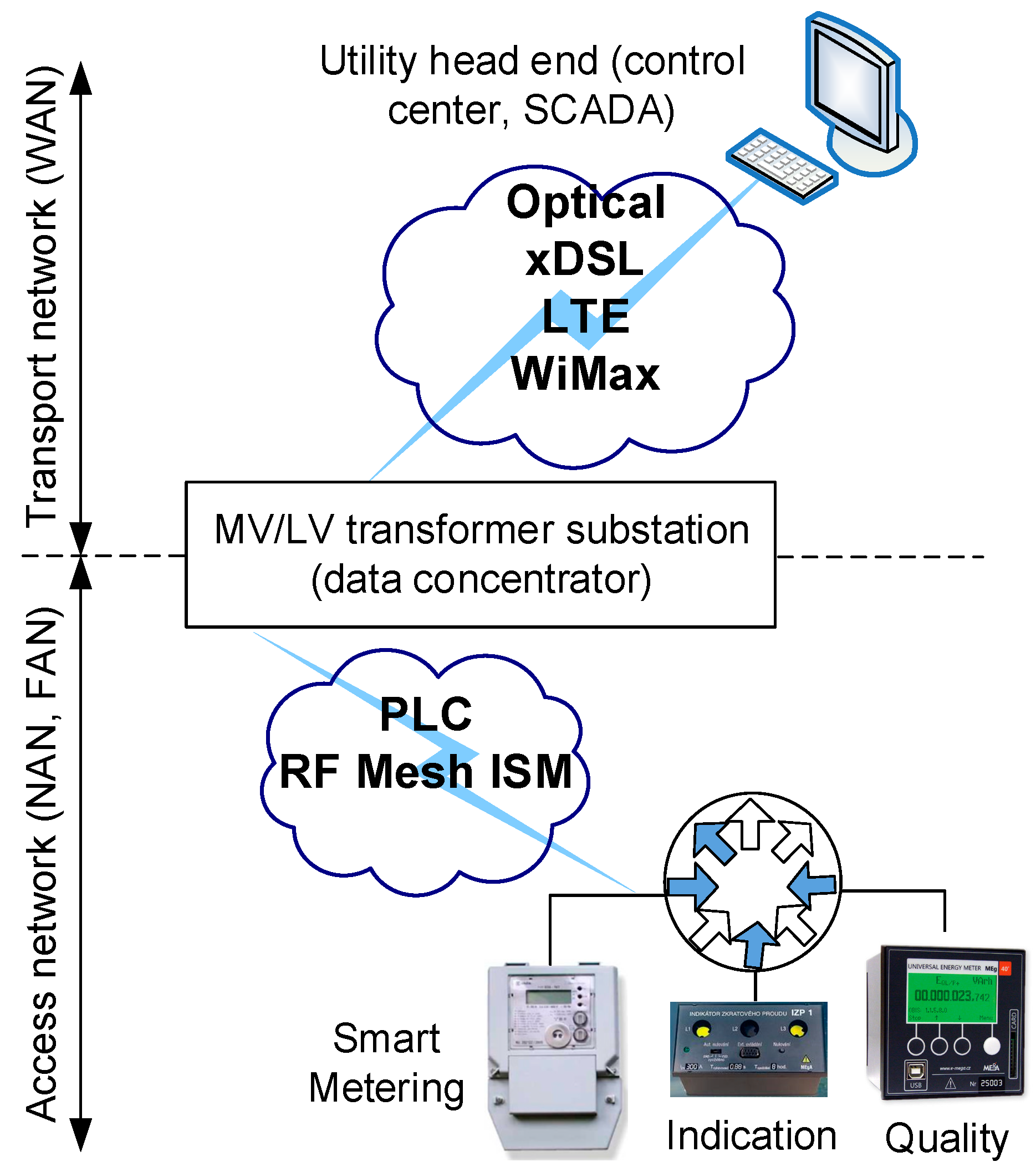
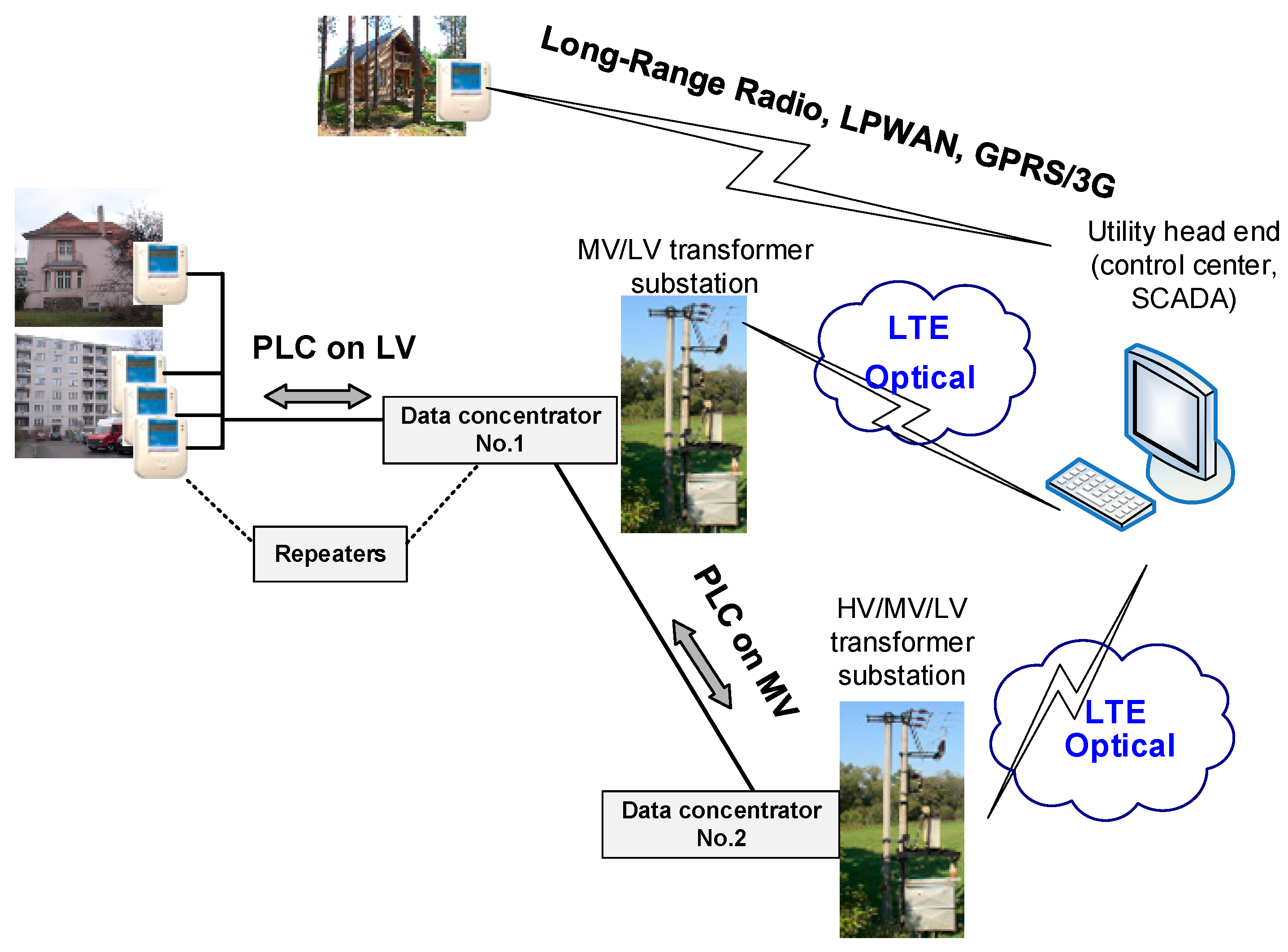
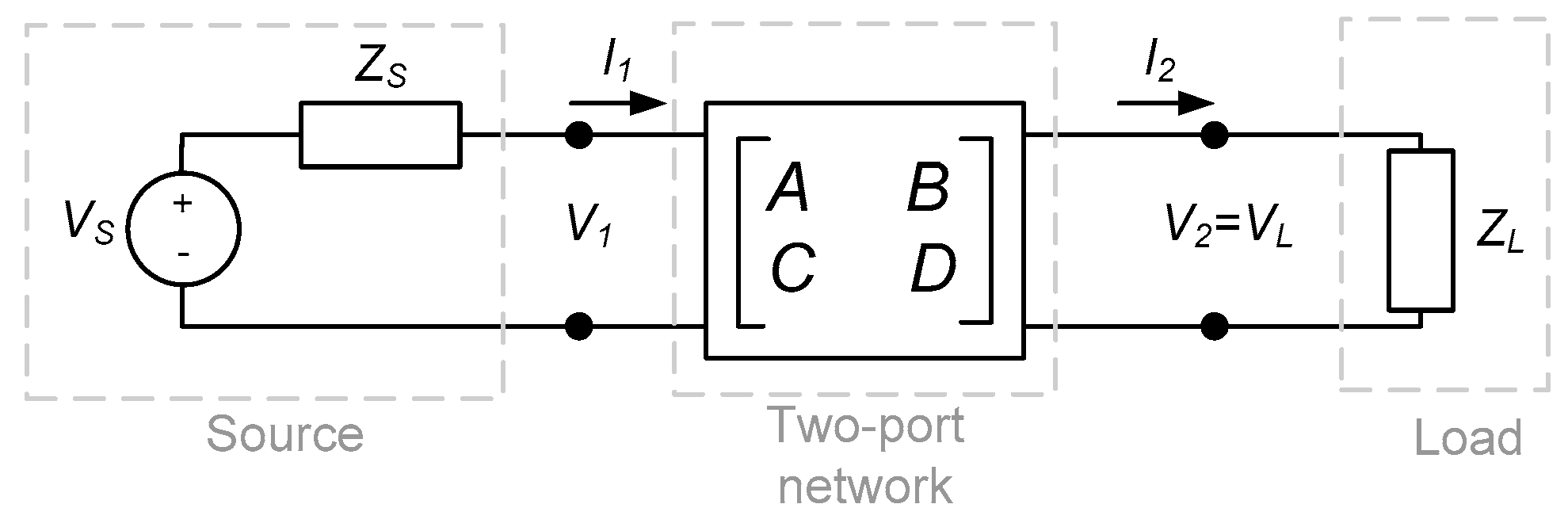

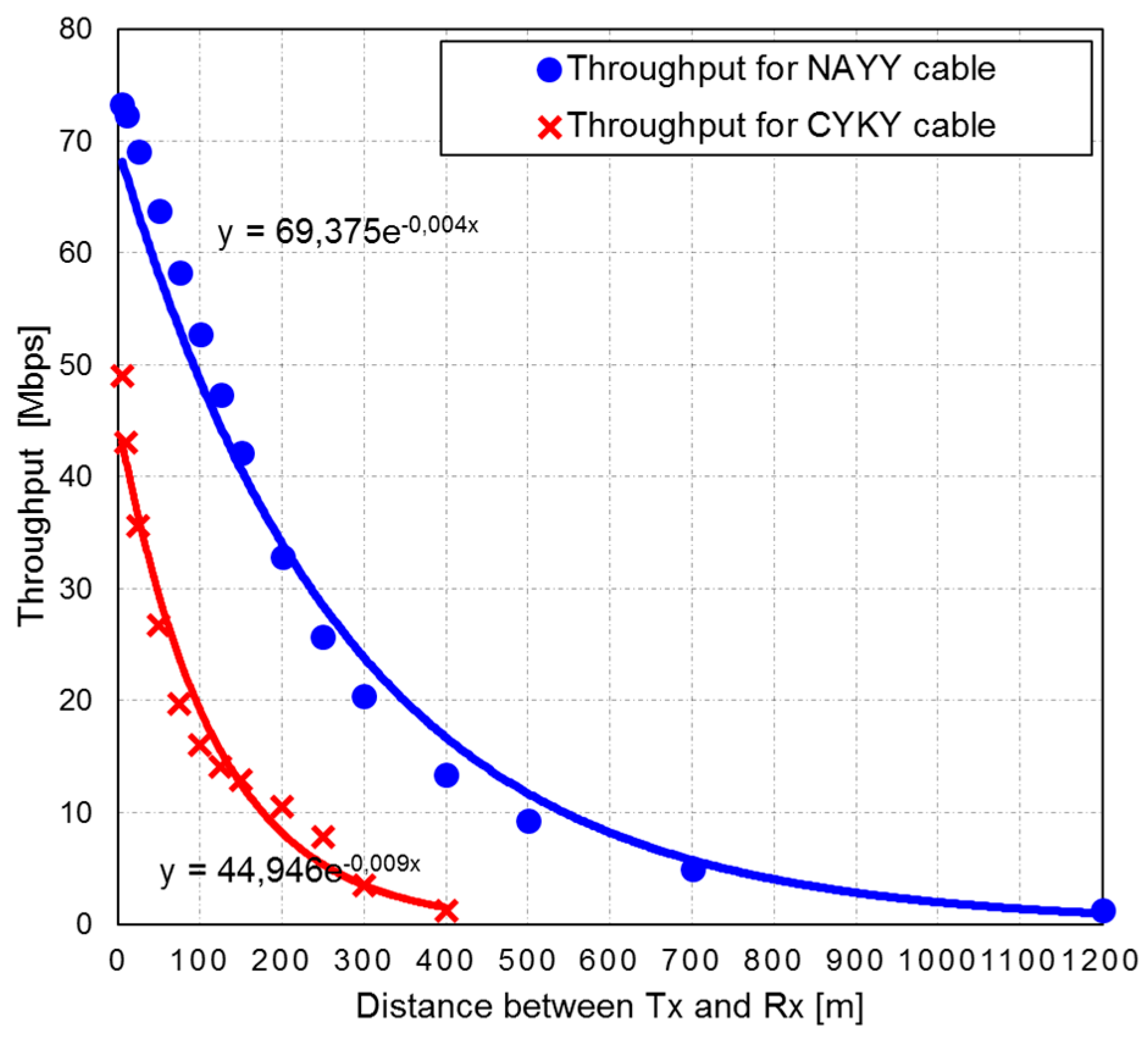

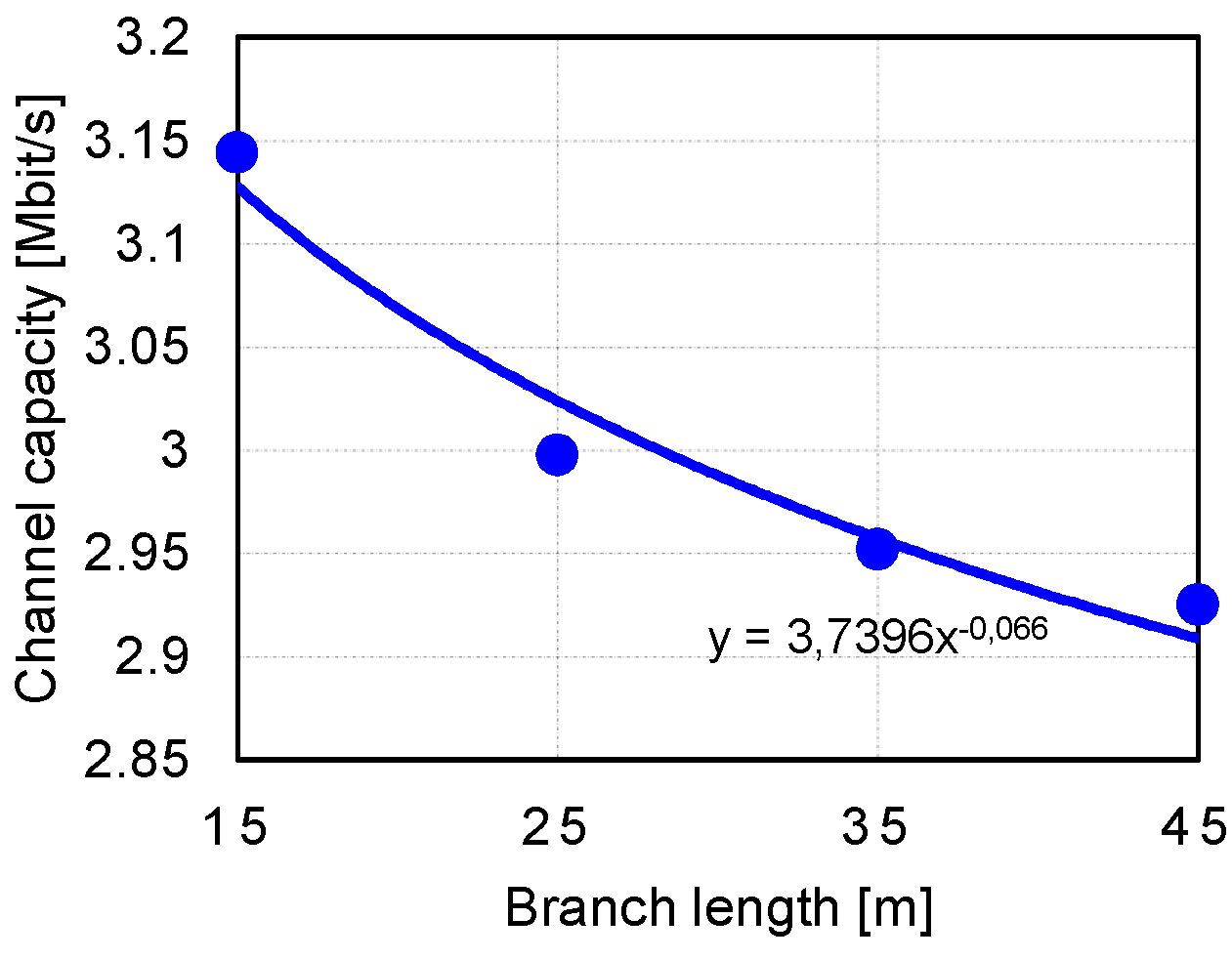
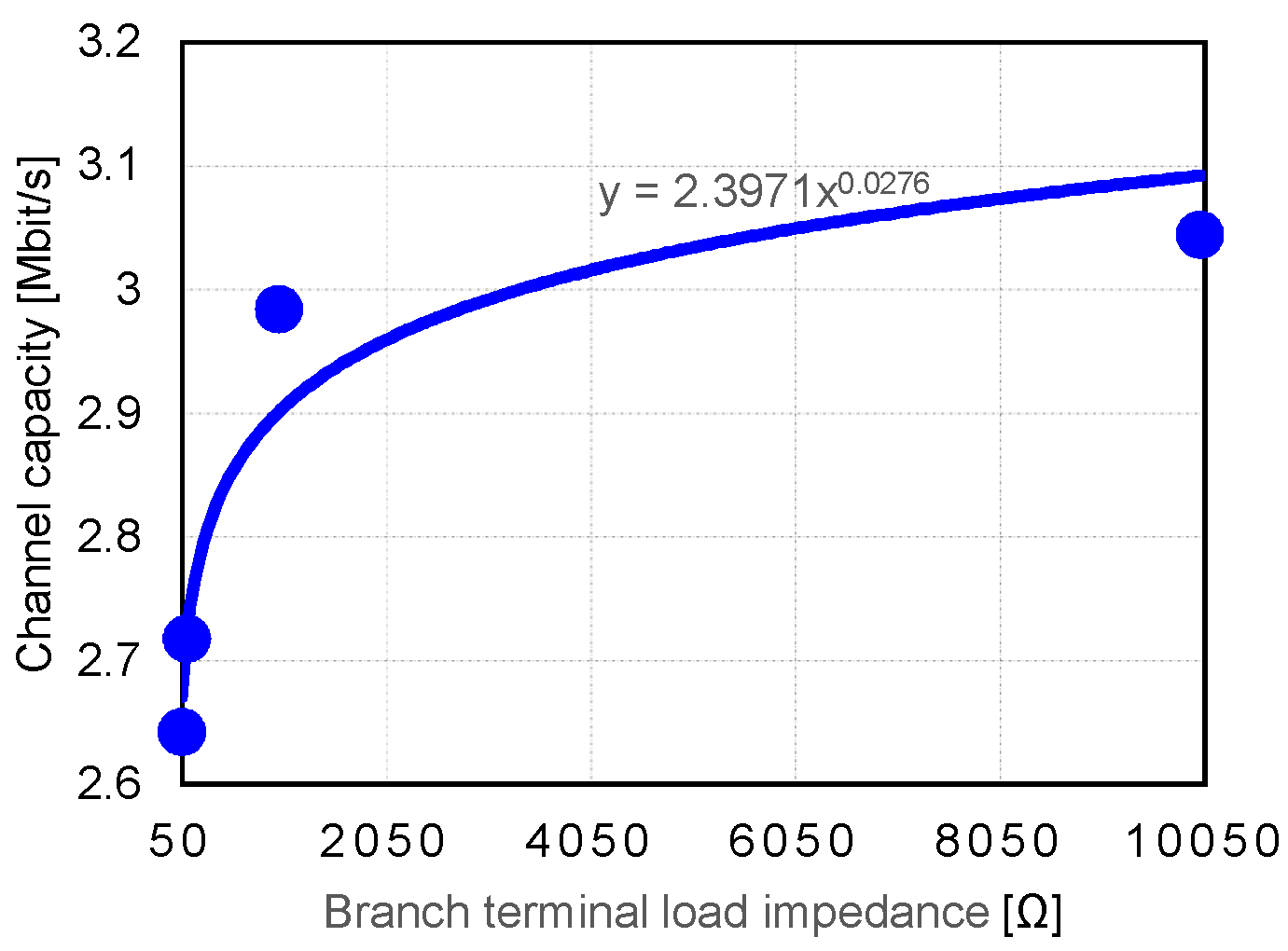
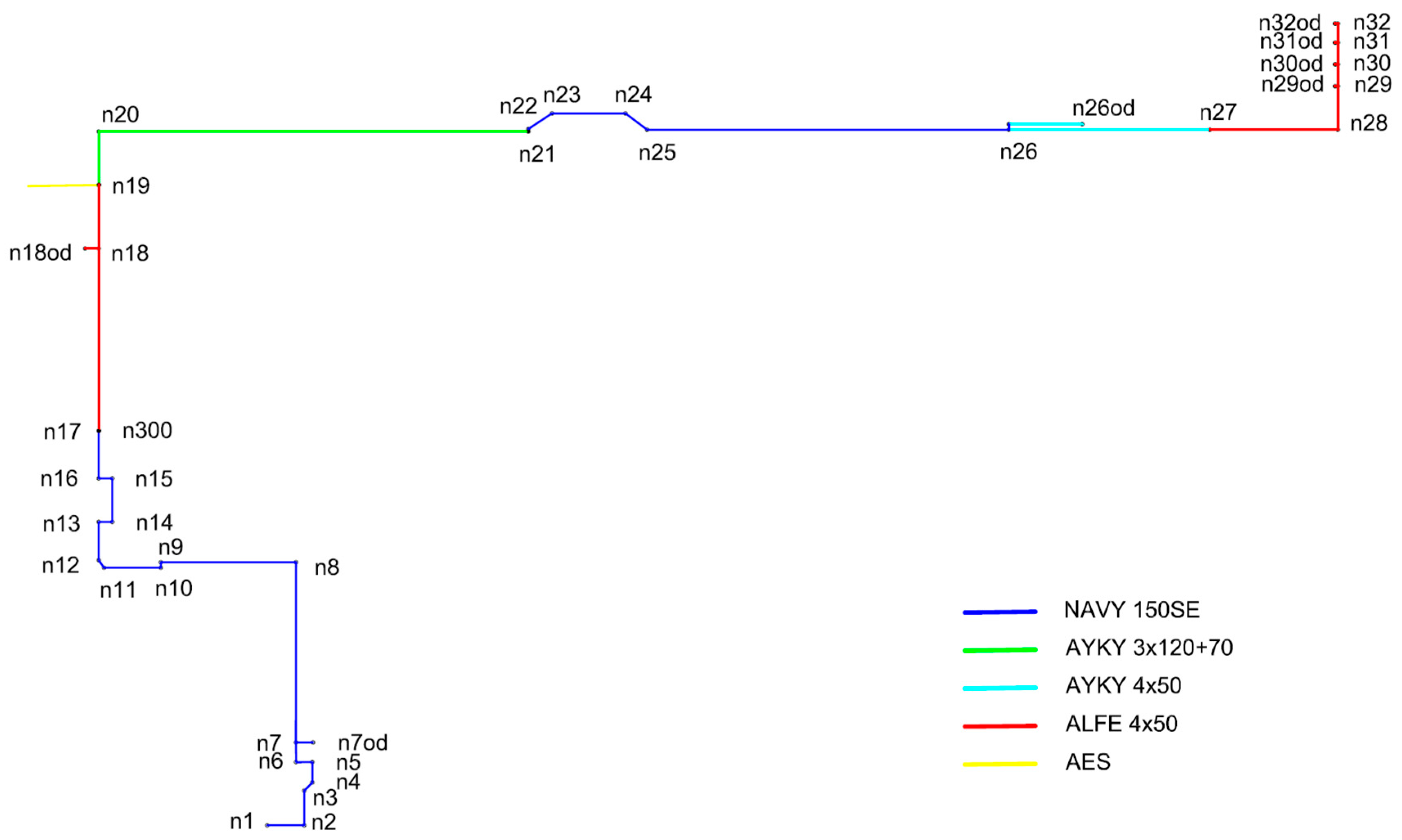
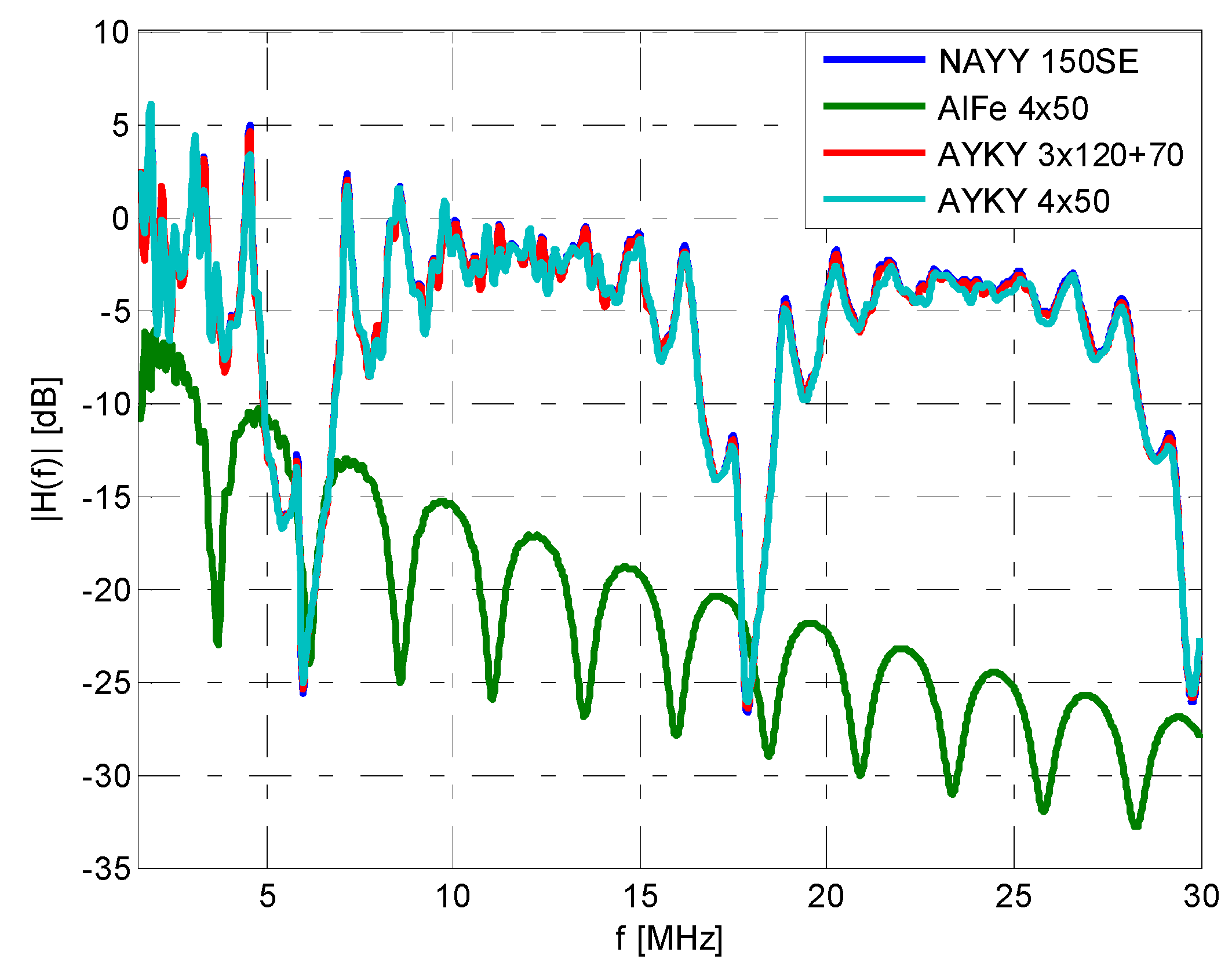
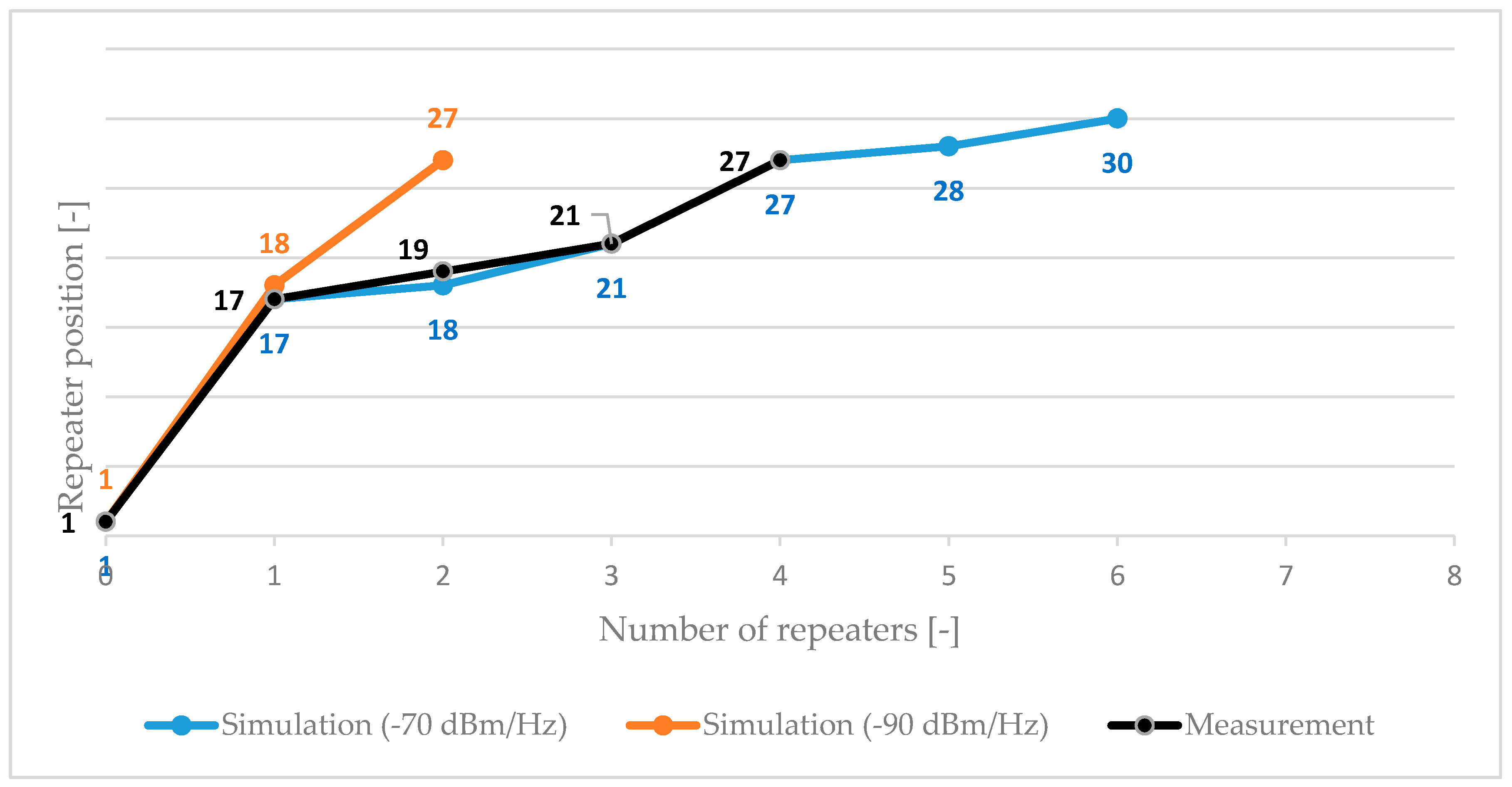
| Measuring Point/Route Section | Distance [m] | Cable Type | Throughput on Physical Layer [Mbps] |
|---|---|---|---|
| n1 → n17 | 231 (102 + 75 + 54) | NAYY 150SE | 15.4 |
| n17 → n18 | 65 | ALFE 4 × 50 | 1.68 |
| n18 → n21 | 212 (43 + 169) | ALFE 4 × 50; AYKY 3 × 120 + 70 | 4.9 |
| n21 → n27 | 197 | NAYY 150SE; AYKY 4 × 50 | 82.6 |
| n27 → n28 | 88 | ALFE 4 × 50 | 2.2 |
| n28 → n30 | 22 | ALFE 4 × 50 | 6.2 |
| n30 → n32 | 21 | ALFE 4 × 50 | 6.2 |
| Cable Type | Throughput on Physical Layer [Mbps] |
|---|---|
| NAYY 150SE | 47.94 |
| ALFE 4 × 50 | 6.30 |
| AYKY 3 × 120 + 70 | 47.45 |
| AYKY 4 × 50 | 46.83 |
| Measuring Point | Distance from TS [m] | Possibility of Communication | |
|---|---|---|---|
| BPL | NB-PLC Single Carrier | ||
| Smart Meter no. 32 | 836 | NO | NO |
| (long distances, lack of repeaters, transition between underground, and overhead) | (communication in the near fuse box (no. 28) was possible) | ||
| Smart Meter no. 26od | 705 | NO | YES |
| (long distances, lack of repeaters) | (BPSK, 5 kb/s) | ||
| Measuring Point | Distance from TS [m] | Possibility of Communication |
|---|---|---|
| BPL | ||
| Smart Meter no. 32 | 835 | YES |
| (repeaters: n17, n19, n21, n27) | ||
| Smart Meter no. 26od | 705 | YES |
| (repeaters: n17, n19, n21) |
| Simulation with Background Noise −70 dBm/Hz | Simulation with Background Noise −90 dBm/Hz | Measurement | |||
|---|---|---|---|---|---|
| BPL Path/Route Section | Distance [m] | BPL Path/Route Section | Distance [m] | BPL Path/Route Section | Distance [m] |
| n1 → n17 | 231 | n1 → n18 | 296 | n1 → n17 | 231 |
| n17 → n18 | 65 | n18 → n27 | 409 | n17 → n19 | 108 |
| n18 → n21 | 212 | n27 → n32 | 131 | n19 → n21 | 169 |
| n21 → n27 | 197 | n21 → n27 | 197 | ||
| n27 → n28 | 88 | n27 → n32 | 131 | ||
| n28 → n30 | 22 | ||||
| n30 → n32 | 21 | ||||
© 2019 by the authors. Licensee MDPI, Basel, Switzerland. This article is an open access article distributed under the terms and conditions of the Creative Commons Attribution (CC BY) license (http://creativecommons.org/licenses/by/4.0/).
Share and Cite
Mlynek, P.; Misurec, J.; Silhavy, P.; Fujdiak, R.; Slacik, J.; Hasirci, Z. Simulation of Achievable Data Rates of Broadband Power Line Communication for Smart Metering. Appl. Sci. 2019, 9, 1527. https://doi.org/10.3390/app9081527
Mlynek P, Misurec J, Silhavy P, Fujdiak R, Slacik J, Hasirci Z. Simulation of Achievable Data Rates of Broadband Power Line Communication for Smart Metering. Applied Sciences. 2019; 9(8):1527. https://doi.org/10.3390/app9081527
Chicago/Turabian StyleMlynek, Petr, Jiri Misurec, Pavel Silhavy, Radek Fujdiak, Jan Slacik, and Zeynep Hasirci. 2019. "Simulation of Achievable Data Rates of Broadband Power Line Communication for Smart Metering" Applied Sciences 9, no. 8: 1527. https://doi.org/10.3390/app9081527
APA StyleMlynek, P., Misurec, J., Silhavy, P., Fujdiak, R., Slacik, J., & Hasirci, Z. (2019). Simulation of Achievable Data Rates of Broadband Power Line Communication for Smart Metering. Applied Sciences, 9(8), 1527. https://doi.org/10.3390/app9081527







